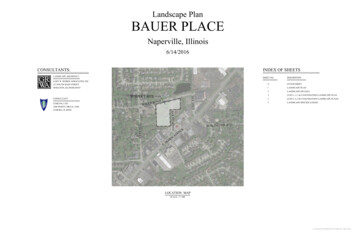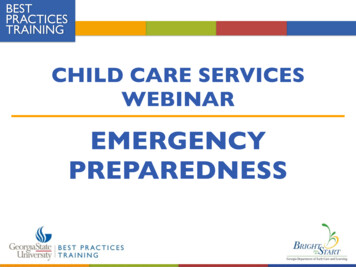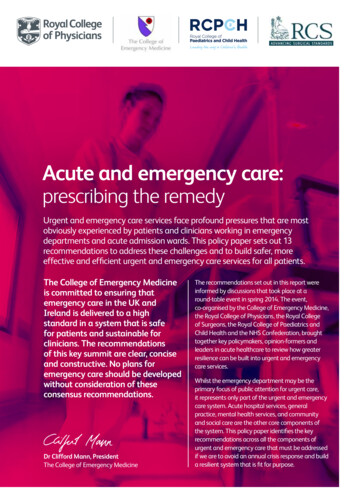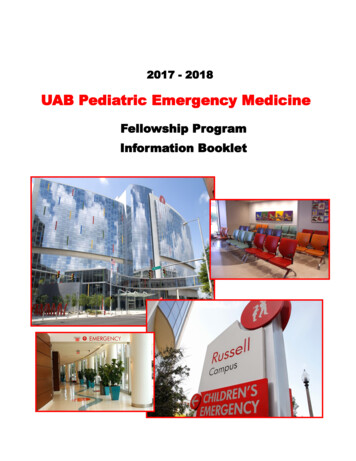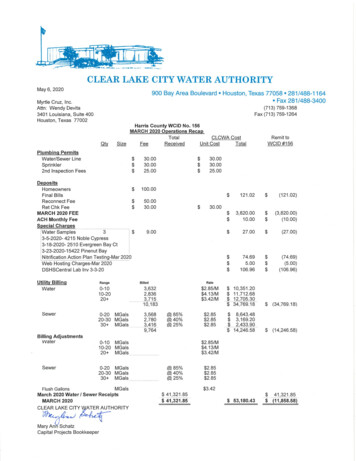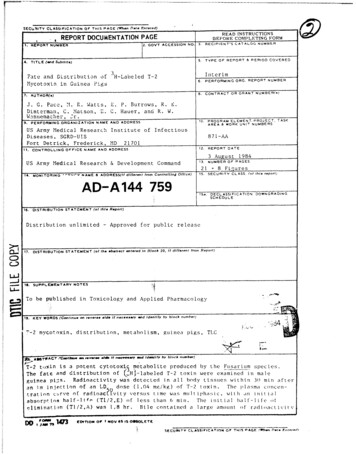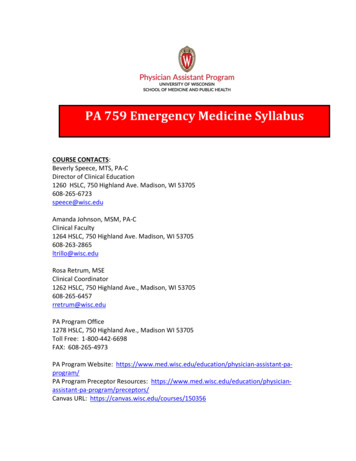
Transcription
PA 759 Emergency Medicine SyllabusCOURSE CONTACTS:Beverly Speece, MTS, PA-CDirector of Clinical Education1260 HSLC, 750 Highland Ave. Madison, WI 53705608-265-6723speece@wisc.eduAmanda Johnson, MSM, PA-CClinical Faculty1264 HSLC, 750 Highland Ave. Madison, WI 53705608-263-2865ltrillo@wisc.eduRosa Retrum, MSEClinical Coordinator1262 HSLC, 750 Highland Ave., Madison, WI 53705608-265-6457rretrum@wisc.eduPA Program Office1278 HSLC, 750 Highland Ave., Madison WI 53705Toll Free: 1-800-442-6698FAX: 608-265-4973PA Program Website: tant-paprogram/PA Program Preceptor Resources: ant-pa-program/preceptors/Canvas URL: https://canvas.wisc.edu/courses/150356
COURSE OVERVIEW:The Emergency Medicine rotation is a required, 8 – credit course where the student isexpected to complete a minimum of 320 clinical hours on rotation (40 hours per week).In addition, the student is expected to complete at least 40 hours (1 hour per day) onthe following activities: studying, completion of evaluations, patient encounter logging,Aquifer cases, reflection cards, and any additional course activities/requirements. Thestudent will learn in an emergency room setting. The emergency medicine rotation isdesigned to provide the second-year/third year PA student with the knowledge andskills necessary to perform in the emergency room setting. For additional informationand expectations of the course, please see the Clinical Year Student and PreceptorHandbook.EMERGENCY MEDICINE PRECEPTORSHIP COURSE GOALS:1. Provide the student with the opportunity and access to a diverse population ofpatients and a variety of diseases and injuries commonly encountered in anemergency room setting.2. Support ongoing development and mastery of the student's ability and skill inobtaining a patient centered focused medical history, conducting a focused physicalexamination, recommending diagnostic studies and discussing and recommendingtreatment plans with the guidance of a preceptor.3. Provide ongoing interactive opportunities for the student to deepen their knowledgeregarding various diagnostic studies used in the evaluation of disease and injury anddisease prevention.4. Provide supervised patient care based opportunities, which foster the developmentof the student's ability to recommend, select and interpret (where applicable)appropriate diagnostic methods in the evaluation of a patient.5. Provide clinical based opportunities to continue to develop the student's ability togenerate differential diagnoses.6. Provide clinical based opportunities to continue to develop clinical skills/proceduresoften used in an emergency room settingEMERGENCY MEDICINE PRECEPTORSHIP LEARNING OUTCOMES:At the end of this eight-week experience students will be able to:1. Complete a problem-oriented history and physical examination specific to thepatient’s chief complaint.2. Complete a focused history and physical exam3. Appropriately document patient encounters using SOAP note format (Subjective,Objective, Assessment and Plan).
4. Accurately order and interpret laboratory evaluations/diagnostic studies essential todetermining the patient diagnosis (es).5. Formulate a reasoned differential diagnosis for a patient problem paying closeattention to those diagnoses that are most life-threatening.6. Formulate an appropriate treatment plan, based on the patient’s H&P, andlaboratory results/diagnostic findings, with emphasis on problems commonly seen inan emergency room setting.7. Participate actively in patient care and management under preceptor supervision.(The level of engagement will be logged in Exxat).8. Educate and counsel patients with common acute diseases across the lifespan thatare commonly seen in an emergency room setting.9. Educate, counsel and promote patients in healthy lifestyles and illness preventionacross the lifespan.10. Synthesize and apply medical knowledge and treatment in an evidence-basedmanner in the care of patients.11. Attend to the emotional as well as physical health needs of the patient and family,with consideration of individual sociocultural and psychosocial factors.12. Work as an effective member of an interprofessional health care team andparticipate in coordinated, quality, team-based care.13. Develop relationships with and participate in clear, succinct, positive, respectfulcommunications and interactions with all peers and related staff.14. Participate in positive, respectful communications and interactions with all patientsand their families, including effectively eliciting patient complaint, utilizing goodlistening skills, and practicing confidentiality.15. Perform procedures commonly encountered in an emergency room setting likesuturing, splinting, and others.16. Understand of the challenges and rewards of a career in Emergency Medicine.EMERGENCY MEDICINE ROTATION -SPECIFIC OBJECTIVES:These objectives are to guide the student in preparing for the Post Rotation examinationby defining areas of content to be emphasized and studied as well as the clinical skills andprofessional behavior required and expected during this practicum.Outline to this information is as follows: Alignment to the PA Core Competencies Organ system based conditionsAlignment to the PA Core Competencies Interpret the clinical features, differential diagnosis, andmanagement of common acute and chronic medical conditionsMedical Knowledgeseen in the ambulatory medical setting. Recognize the impact of disease on individuals and societallevels
Compare preventive strategies for common acute and chronicmedical conditions seen in the ambulatory setting, in the clinic,and at the population level. .Patient CarePractice-Based Learning andImprovementInterpersonal and CommunicationSkillsSystem Based PracticeProfessionalism Perform focused histories and physical exams relevant tocommon acute and chronic medical conditions. Perform comprehensive wellness exams relevant to patient’sage and comorbidities. Formulate treatment plans for common acute and chronicambulatory medical problems. Use test characteristics, predictive values, and likelihood ratiosto enhance clinical decision making. Distinguish preventive screening tests for individual patients,acknowledging prevalence, risk factors, and outcomes. Formulate answerable clinical questions from patientinteractions Practice life-long learning skills, including the use of evidencebased medicine at point of care. Differentiate and appraise preventive service guidelines andrecommendations from various organizations. Identify individual learning goals, and self-assess knowledgeand behaviors Present cases to preceptor in a patient-centered manner,integrating further testing recommendations, diagnosticprobabilities, and evidence-based treatmentrecommendations as indicated. Document clinical encounter in written SOAP note form. Establish effective relationships with patients and families. Ascertain patient and family beliefs regarding common acuteand chronic medical conditions. Educate patients and families regarding common acute andchronic medical conditions. Demonstrate the process of negotiating management planswith patients, incorporating patient needs and preferences intocare. Check for patient’s understanding of follow-up plan, includingtreatments, testing, referrals, and continuity of care. Identify community assets and system resources to improve thehealth of individuals and populations. Demonstrate a clinical perspective that recognizes the impactof multiple systems on patient health. Recognize and address self-care and personal issues that affectone’s ability to fulfill the professional responsibilities of being a
physician. Assume responsibility, behave honestly, and perform duties in atimely, organized, respectful, and dependable manner. Seek, accept, and apply constructive feedback appropriately.Learning Objectives for Organ based Conditions:Know etiology, risk factors, prevention, signs and symptoms, diagnostic workup,treatment plan and patient education for (Table 1)Table 1. Acute Presentations with Common/Serious DiagnosisOrgan SystemSymptomsCommon/Serious DiagnosisGastrointestinal/NutritionalAbdominal pain,anorexia,heartburn/dyspepsia, tipation/obstipation/change in bowel habits,melena/hematochezia, bleeding perrectumEsophagitis, Mallory-Weiss tear, Pepticulcer disease, Acute cholecystitis,Cholangitis, Acute hepatitis, Acutepancreatitis, Acute appendicitis,Diverticular disease, Ischemic boweldisease, Inflammatory disease, Toxicmegacolon, Obstruction (small bowel,large bowel, volvulus)Clinical skillor otherStool guiacFAST US examNG tubeplacementAnal fissure/fistula/abscess, Hemorrhoids(thrombosed) , Perirectal abscessHernia(incarcerated/strangulated)Infectious diarrhea,Gastritis, Gastroenteritis,Diarrhea/constipation, Gastrointestinalbleeding, Cirrhosis, Giardiasis and otherparasitic infections, Pyloric stenosis ,Pancreatitis, Pancreatic thiasis, Acutecholecystitis, Carcinoma (colorectal, smallbowel, gastric, pancreatic, esophageal,and hepatic)CardiovascularChest pain, syncope,Conduction disorders (atrialInterpret EKG
dyspnea onexertion,claudication, SOB,Palpitations ,Orthopnea, edemafibrillation/flutter, supraventriculartachycardia, bundle branch block,ventricular tachycardia/fibrillation,premature beats) HypertensiveemergenciesHypotension (cardiogenic shock,orthostatic hypotension) Heart failureInterpret CXRFAST US examACLS/BLSIV accessCoronary heart disease (non-ST acutemyocardial infarction, ST segmentelevation acute myocardial infarction,angina pectoris, unstable angina,Prinzmetal/variant angina)Vascular disease (aorticaneurysm/dissection, arterialocclusion/thrombosis, phlebitis)Valvular disease (aortic stenosis, aorticregurgitation, mitral stenosis, mitralregurgitation) Acute/subacute bacterialendocarditisCardiac tamponade Pericardial effusionPeripheral vascular disease, Arrhythmias ,AnginaPulmonologyShortness of breath,Hemoptysis,Fatigue, Wheezing ,Stridor, Pleuriticchest pain, Cough,FeverCroup, Influenza, Pertussis,Interpret CXRPneumonia (bacterial, viral, fungal,human immunodeficiency virus-related)Chest tubeplacementRespiratory syncytial virusInterpret peakflow meterAsthmaPleural effusion, Pneumothorax,Pulmonary embolismAcute respiratory distress syndrome
Foreign body aspiration TuberculosisLung cancer , Respiratory distressEndocrinologyTremors, Hyperparathyroidism, Hyperthyroidism,Thyroiditis, Adrenal insufficiency,Diabetes insipidus, Diabetic ketoacidosis,Non-ketotic hyperglycemia, Diabetesmellitus, Cushing disease,HypothyroidismAccucheck(blood sugar)Urology/renalEdema,Dysuria HematuriaSuprapubic/flankpainOrthostatic hypotension, Urinaryretention, Acute/chronic renal failure,Renal vascular disease, Nephrolithiasis,Testicular torsion, Cystitis, Epididymitis ,Orchitis, Prostatitis ,PyelonephritisUrethritis, Glomerulonephritis, Fluid andelectrolyte disorders, Acid/basedisorders, HerniasUA analysisChange in vision,change in speech,motor and/orsensory loss,Vertigo Seizure(symptom)Vascular disorders (carotid disease)Headache (migraine, cluster, tension,acute glaucoma)Meningitis, Encephalitis, Transientischemic attack, Stroke, Subarachnoidhemorrhage/cerebral aneurysmIntracerebral hemorrhage, Altered levelof consciousness/coma, Headtrauma/concussion/contusion,Epidural/subdural hematoma, Seizuredisorders, Status epilepticus, Syncope,Guillain-Barre syndrome, Spinal cordinjury, Delirium, Dementia , Bell Weakness/paralysis,loss ofconsciousness/change in mentalstatus Loss ofmemory, Loss ofcoordination/ataxia,Headache, FeverUrine dipstickCSF analysis
DermatologyRash, Pruritis,Redness/erythema,Discharge, Blisters,Lacerations, FeverCellulitis, Burns, Hidradenitis suppurativa,Dermatitis (eczema, contact) Drugeruptions, Stevens-Johnson syndrome,Toxic epidermal necrolysis, Bullouspemphigoid,Lacerations (simple/complex), Animalbites, Spider l blocksLice, Scabies, Viral exanthems, Herpeszoster, Erysipelas, MRSA, Impetigo,Urticaria, Pilonidal disease, Pressure sores igueAnemia, Aplastic anemia, Hemolyticanemia, Sickle cell anemia/crisis Clottingfactor disorders, DVT, Hypercoagulablestates, Thrombocytopenia, Acuteleukemia, Lymphomas , Leukemias,PolycythemiaOB/GYNAbdominal/pelvicpain, Vaginaldischarge, Dysmenorrhea, Amenorrhea,FeverDysfunctional uterine bleeding,Endometriosis, Ovarian cysts, Vaginitis,Pelvic inflammatory disease,Mastitis/breast abscess Spontaneousabortion, Abruption placenta, Ectopicpregnancy, Placenta previa, Prematurerupture of membranes, Fetaldistress Intrauterine pregnancy, SexualassaultPelvic examSTD culturesFetal hearttones (FHT)Wet Prep(KOH)Urine pregtestPsychFatigue,hallucinations,altered mentalstatus, chest pain,suicidal ideationNeurocognitive disorders, Bipolar andrelated disorders,Schizophrenia spectrum and otherpsychotic disorders, Depressivedisorders, Anxiety disorders, Panicdisorder, Posttraumatic stress disorder,Substance use disorders, Spouse orpartner neglect/violence, Suicide, Sexual
assaultOrthopedic/RheumatologyPain, ess/tinglingFractures/dislocations (shoulder,forearm/wrist/hand, hip, knee,ankle/foot), Soft tissue injuries,Back strain/sprain, Low back pain, Caudaequine, Herniated disk, Osteomyelitis,Septic arthritis, Costochondritis,Bursitis/tendonitis Gout, Sprains/strains,Compartment SyndromeJointaspirationSplintingInterpret XraysJointreductionCervical spinemanagementENT/OphthalToxicologyVision loss, Nasalcongestion, Sorethroat, Earpain, Vertigo, Fever,Muffled voice, EyepainAltered mentalstatus, FeverBlepharitis, Conjunctivitis, Blow-outfracture, Corneal abrasion/ulcer,Dacryoadenitis, Foreign body (eye, ear,nose) Glaucoma (acute angle closure),Hyphema, Macular degeneration (wet),Optic neuritis, Orbital cellulitis,Papilledema, Retinal detachment, Retinalvein occlusion, Otitis externa, Acuteotitis media, Trauma/hematoma (externalear), Barotrauma, Labyrinthitis,Mastoiditis, Peritonsillar abscess,Dental abscess, Acutelaryngitis, Epiglottis, Tympanicmembrane perforation, Cornealabrasion/ulcer, Allergic rhinitis, Acutesinusitis, Acute pharyngitis(bacterial/viral), EpistaxisOverdose (acetaminophen, aspirin,tricyclic antidepressants, carbonmonoxide, toxic alcohols, narcotics)TraumasurveyNasal swabPharyngealswabSlit lampEpistaxispackingEye irrigationFB removal
*Based on the PAEA EOR exams.Learning Objectives for EM Boot Camp ACLS review: Be able to identity the correct steps and treatments in the ACLSalgorithms.Orthopedic review: Review and demonstrate splinting techinques for commonorthopedic injuries seen in an emergency setting.Suture practice: Review and demonstrate suturing techniques often utilized inan ED setting.Recommended Resources1. Fauci A. Harrison’s Principles of Internal Medicine. McGraw-Hill.2. Hamilton RJ. Tarascon Pharmacopoeia. (Pocket or PDA version)3. Gilbert DN, Chambers HF, Eliopoulos GM. Sanford Guide to AntimicrobialTherapy . (Pocket or PDA version)4. Netter, FH. Atlas of Anatomy. Saunders.5. Trott, AT. Wounds and Lacerations: Emergency Care and Closure.Elsevier/Saunders.6. Emergency Medicine: A Comprehensive Study Guide,(Tintinalli, et al)7. Rosen’s Emergency Medicine, (Marx et al).Recommended WebsitesUpToDateGuide to Clinical PreventiveServicesAmerican Family PhysiciansAmerican MedicalAssociation h.gov/books/NBK16363/www.aafp.orgwww.theasgs.org
American Academy ofPhysician Assistants (AAPA)6.11.2019www.aapa.org
medical conditions seen in the ambulatory setting, in the clinic, and at the population level . . Patient Care Perform focused histories and physical exams relevant to common acute and chronic medical conditions. . PA 759 Emergency Medicine Syllabus
